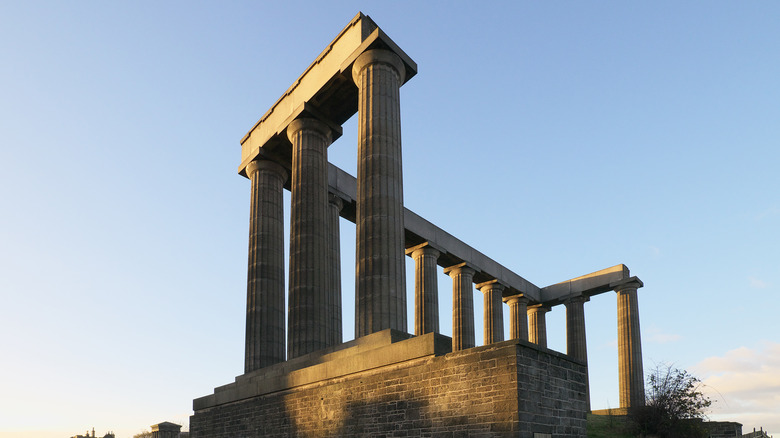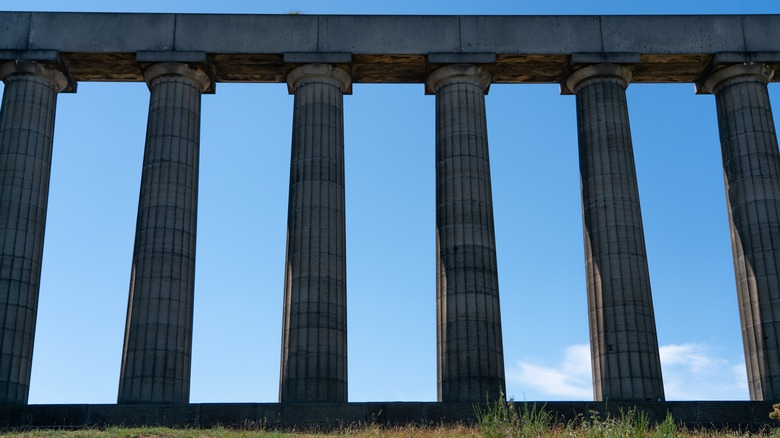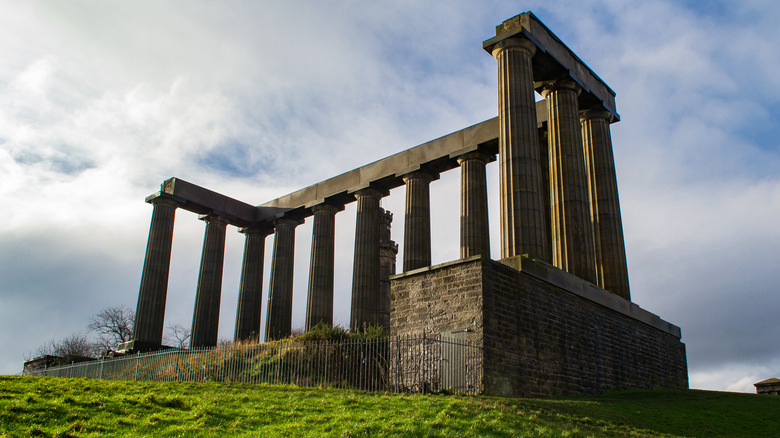The National Monument Nicknamed 'Scotland's Disgrace' That's Still Standing Today
Scotland has no shortage of fascinating historical events and monuments to pay tribute to them. One of the more, shall we say, "unique" monuments is often referred to as "Scotland's Disgrace," among other less than flattering names. As stated in Historic UK, this monument's genesis goes back to 1815 when the idea was proposed to honor the lives lost in the Napoleonic Wars. While this shrine was intended to be built in London, it was also proposed that another be constructed in either Edinburgh or Dublin to allow visitors to pay their respects without having to travel to London. It was soon decided that Edinburgh would be the home of the monument, as it would also spur interest in the country.
According to The Scotsman, the memorial was designed by William Playfair and was based on the Parthenon in Athens, Greece. Its other features included a church interior and catacombs beneath the monument, essentially combining multiple elements to celebrate the lives and deaths of brave Scotsmen. Once the design was agreed on, Scottish luminaries like Sir Walter Scott, Lord Elgin, and Lord Cockburn set out to promote the project and raise the necessary funds to build it. With so much going for the monument, what went wrong?
Why the monument is a disgrace
It's hard to believe that an endeavor with so much support and good intentions behind it would end up being an embarrassment to a whole country, but that's exactly what happened with the famed monument. The Scotsman states that, despite the fact that only a fraction of the necessary funds had been gathered, 1826 saw construction on the monument commence under the impression that the rest of the funds would be on the way. But this never came to pass, and construction ended in 1829 with only part of the structure built. Another problem that the memorial faced was that nearby Edinburgh was quickly growing, which meant that numerous other civic construction projects took precedence over the monument, so it fell by the wayside.
Of course, if only the monument's supporters had paid more attention to the signs early on before its construction, perhaps it would've been met with a better fate. Historic UK chronicles when, in 1822, King George IV was to visit Edinburgh and raise awareness for the project, but the king instead joined some Scottish noblemen to go shooting for the day, severely hampering the progress of the memorial. An important lesson for all civic engineers: When your monarch skips out on a meeting to show his support for your proposed endeavor to hang with his buddies, it's best to put the project on the back burner.
The modern life of a failed monument
According to The Scotsman, there have been numerous attempts to resume construction of "Scotland's Disgrace," but none of them ever led to anything. There was a time when Glasgow council proposed to resurrect the project and fund its completion, but only under the condition that the city's coat of arms would be on the memorial. The city of Edinburgh rejected this proposal, which led to another unflattering nickname for the monument: "the pride and the poverty."
Historic UK states that the lonely columns of the failed monument have become a permanent feature of the hills that surround Edinburgh, and so iconic that locals don't seem interested in changing it. In fact, there was another plan to upgrade the memorial as recently as 2004 that was met with an unenthusiastic response, confirming that the only ones interested in restoring the structure to its original intended glory are architects. In short, don't expect the monument to be renamed "Scotland's Triumph" anytime soon.


